In June of 1881, Dartmouth College sophomore Ernest B. Balch and his Camp
Chocorua staff built a small cabin on an island in Squam Lake, New Hampshire.
Then they waited. They hoped that boys from East Coast cities like Boston and
New York would begin to arrive, ready to spend ten weeks at Chocorua, one of
the first summer camps in the nation's history.
In July, the first camper, Charlie Benjamin, arrived from Washington, DC. Soon,
his cousin followed. Then three more boys arrived from Boston. These boys would
spend an entire summer as no boys had ever before--as part of an organized
summer camp. And over nine camping seasons, dozens of other boys would share
the Chocorua experience.
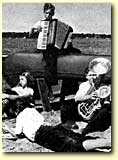 Many of the campers at Chocorua were the sons of well-to-do parents who spent
their summers at luxury hotels in places such as New Hampshire's White
Mountains. Ernest Balch believed that these boys, as well as boys stuck in the
city for the whole summer with nothing to do, would quickly get bored--and even
get into trouble.
Many of the campers at Chocorua were the sons of well-to-do parents who spent
their summers at luxury hotels in places such as New Hampshire's White
Mountains. Ernest Balch believed that these boys, as well as boys stuck in the
city for the whole summer with nothing to do, would quickly get bored--and even
get into trouble.
Balch set up Chocorua to teach boys the self-reliance and the skills they
needed to become men. There were no servants at Chocorua. Campers cut firewood,
cooked their own meals, and washed their own dishes. Each boy got an allowance
of 25 cents per week. If he wanted more money, he had to earn it by doing camp
chores.
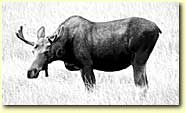 Chocorua was work, but it was fun, too. The boys lived in rough wooden
buildings, like pioneers. They learned how to sail a boat and how to catch
fish, how to use an axe and survive in the wilderness. They swam in Squam Lake
and hiked in nearby mountains. Sadly, the fun didn't last forever. In 1888, the
Camp Chocorua closed, with Ernest Balch $8,000 in debt. But Chocorua had helped
start a movement that would change summer vacations forever.
Chocorua was work, but it was fun, too. The boys lived in rough wooden
buildings, like pioneers. They learned how to sail a boat and how to catch
fish, how to use an axe and survive in the wilderness. They swam in Squam Lake
and hiked in nearby mountains. Sadly, the fun didn't last forever. In 1888, the
Camp Chocorua closed, with Ernest Balch $8,000 in debt. But Chocorua had helped
start a movement that would change summer vacations forever.
After Chocorua got its start, other camps sprang up, many of them on lakes in
New England. Camp Harvard opened in Stow, Massachusetts in 1882. Camp Dudley in
Westport, New York followed in 1885. By 1900, more than 20 summer camps
existed. But the boom was just beginning. In 1925, kids could choose from more
than 1,000 camps, which offered a whole summer of camping, room and board
included, for as little as $100.00.
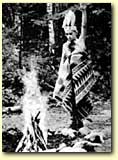 Each camp had its own style. At some camps, kids slept in cabins. In others,
they slept in tents--or even Native American-style tepees. The Native American
lifestyle was often an important camp theme. While some campers worked as hard
as those at Chocorua, most didn't. Camps were, after all, a business. And most
"customers" didn't want to cook and wash dishes. Still, at almost every camp,
chores were a part of daily life.
Each camp had its own style. At some camps, kids slept in cabins. In others,
they slept in tents--or even Native American-style tepees. The Native American
lifestyle was often an important camp theme. While some campers worked as hard
as those at Chocorua, most didn't. Camps were, after all, a business. And most
"customers" didn't want to cook and wash dishes. Still, at almost every camp,
chores were a part of daily life.
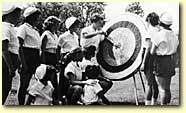 During a camp's daytime hours, kids swam and hiked, studied nature, learned
outdoor skills, did arts and crafts, and played games. At night, they gathered
around the campfire, to sing songs, tell stories, and put on plays. But one
things they didn't usually do was spend time with kids of different races,
religions, genders, or social classes.
During a camp's daytime hours, kids swam and hiked, studied nature, learned
outdoor skills, did arts and crafts, and played games. At night, they gathered
around the campfire, to sing songs, tell stories, and put on plays. But one
things they didn't usually do was spend time with kids of different races,
religions, genders, or social classes.
At the turn of the century, America was segregated. People of different races,
religions, and income groups vacationed separately. Many resorts catered to
white Christians only--African American and Jewish vacationers, for example,
were kept out. Men and women had strictly defined roles.
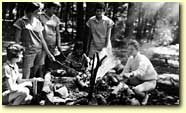 Summer camps were similarly divided. The earliest camps served only boys, But
soon, girls got in on the act. In 1892, Camp Arey in Arey, New York, became the
first to admit girls. And in 1900, Mrs. Oscar Holt founded Redcroft, the first
all-girl camp, in Hebron, New Hampshire.
Summer camps were similarly divided. The earliest camps served only boys, But
soon, girls got in on the act. In 1892, Camp Arey in Arey, New York, became the
first to admit girls. And in 1900, Mrs. Oscar Holt founded Redcroft, the first
all-girl camp, in Hebron, New Hampshire.
It took nearly twenty years before
Jewish kids had a camp to call their own. In 1902, Camp Cobbossee, a Jewish
Camp for boys, opened in Winthrop, Maine. Within a decade, nearly ten Jewish
camps existed, including Camp Wigwam, in Harrison, Maine, and Camp Songo, in
Casco, Maine.
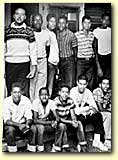 Camp Atwater, founded in 1921 by Dr. William N. DeBerry, was among the first
camps to serve African American campers. Located on Lake Lashaway in
Brookfield, Massachusetts, Camp Atwater focuses on the academic and social
growth and development of its campers. Seventy-eight years after it opened,
it's still in business. Camp Atwater, founded in 1921 by Dr. William N. DeBerry, was among the first
camps to serve African American campers. Located on Lake Lashaway in
Brookfield, Massachusetts, Camp Atwater focuses on the academic and social
growth and development of its campers. Seventy-eight years after it opened,
it's still in business.
Early on, educators and social workers realized that poor kids needed camps,
too. Camps founded by the Salvation Army, Young Women's Christian Association
(YWCA), and other religious and charity organizations, provided free or
reduced-rate camps for needy city kids.
Some camps offered special programs as a way of attracting campers. At Camp
Mechano, boys got a mechanic's-eye view of automobiles, boats, and radios.
Valley Ranch, in Wyoming, offered campers an 800-mile horseback camping trip.
At Camp Songo, Mrs. Alice Minnie Herts Heniger of The Children's Educational
Theater, New York, gave "specialized dramatic instruction."
Kids with special physical or mental health needs could also choose from a
small number of specialized camps. These camps offered care and supervision by
doctors and nurses in addition to water sports, campfires, and fun. Some camps
even tried to teach kids politics. In the 1930's and 40's, camps such as Camp
Wo-Chi-Ca in port Murray, New Jersey, taught kids Communist and socialist
political beliefs alongside traditional camp skills.
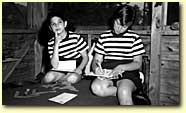 If kids had lots of choices at camp, they were often bound by strict rules and
honor codes as well. The rules listed in 1929 a brochure for Camp Wihakowi, in
Northfield, Vermont, reminded girls that they "Must not wear stockings rolled
below the knee except by permission," and that they "Must conform to the rules
governing the use of candy, sodas, ice cream, and eating between meals. The
camps song of Camp Pasquaney, written in 1895, states If kids had lots of choices at camp, they were often bound by strict rules and
honor codes as well. The rules listed in 1929 a brochure for Camp Wihakowi, in
Northfield, Vermont, reminded girls that they "Must not wear stockings rolled
below the knee except by permission," and that they "Must conform to the rules
governing the use of candy, sodas, ice cream, and eating between meals. The
camps song of Camp Pasquaney, written in 1895, states
"Here everyone is a good fellow,
We won't stand a cad or sneak
Nor a camper who shirks his fair duties
A liar, a dude, or a freak"
 Campers at Pasquaney still sing that song today. And summer camps remain as
popular as ever. More than 4,000,000 boys and girls of all races, religions,
and social classes will attend some 10,000 camps this summer, exploring
activities from aviation to computers, scuba diving to ranching. If you're one
of those kids, you can share your experiences with a friend or family
electronically. Just click here to send an email postcard. Happy camping!
Campers at Pasquaney still sing that song today. And summer camps remain as
popular as ever. More than 4,000,000 boys and girls of all races, religions,
and social classes will attend some 10,000 camps this summer, exploring
activities from aviation to computers, scuba diving to ranching. If you're one
of those kids, you can share your experiences with a friend or family
electronically. Just click here to send an email postcard. Happy camping!
|
|

